#Lycorma delicatula
Text

Bug of the Day
Spotted lanternflies are taking over my life...
#spotted lanternfly#SLF#lanternfly#invasive species#insect#Hemiptera#Fulgoridae#planthopper#Fulgorid planthopper#Lycorma#Lycorma delicatula#bug#BotD#bug of the day
284 notes
·
View notes
Link
June 28, 2022
The Canadian Council on Invasive Species (CCIS) gave a short presentation of the top 10 invasive species already in Canada or that could come to Canada from south of our border and that we therefore should be on the alert for.
The top 10 invasive species were as follows:
Asian long-horned beetle, Anoplophora glabripennis
Spotted lanternfly, Lycorma delicatula
Asian giant hornet, Vespa mandarinia
Emerald ash borer, Agrilus planipennis
Hemlock woolly adelgid, Adelges tsugae
Brown marmorated stink bug, Halyomorpha halys
Dutch elm disease, Ophiostoma ulmi and Ophiostoma novo-ulmi
Japanese beetle, Popillia japonica
Spongy moth (also LDD moth; previously gypsy moth), Lymantria dispar dispar
Lily leaf beetle, Lilioceris lilii
I have definitely seen at least three of these species and/or the damage they have done, specifically 4, 8, and 9.
You can help by reporting these species through, for example, iNaturalist. CCIS has their own project on iNaturalist, titled “I Spy and Identify Invasives / Je vois, J’identifie les espèces envahissantes”, which you can join: https://www.inaturalist.org/projects/i-spy-and-identify-invasives-je-vois-j-identifie-les-especes-envahissantes. The CCIS also has a whole webpage on how and where to report: https://canadainvasives.ca/take-action/report/.
#wildflowers of southern ontario#invasive species#canada#Canadian Council on Invasive Species#inaturalist#Asian long-horned beetle#Anoplophora glabripennis#Spotted lanternfly#Lycorma delicatula#Asian giant hornet#Vespa mandarinia#Emerald ash borer#Agrilus planipennis#Hemlock woolly adelgid#Adelges tsugae#Brown marmorated stink bug#Halyomorpha halys#Dutch elm disease#Ophiostoma ulmi#Ophiostoma novo-ulmi#Japanese beetle#Popillia japonica#Spongy moth#LDD moth#Lymantria dispar#Lymantria dispar dispar#Lily leaf beetle#Lilioceris lilii
12 notes
·
View notes
Text

8/26/22
The dreaded lanternfly... boogeyman of PA. I've seen pictures for years but was still shocked by their vibrant orange wings.
#spotted lanternfly#Lycorma delicatula#animal#insect#insecta#hemiptera#Auchenorrhyncha#Fulgoromorpha#Fulgoridae
0 notes
Text
spotted lanternflies, Lycorma delicatula. an infamous invasive in my area, but I’ve come to enjoy these clumsy little freaks more than I ever thought I would.

people are oddly obsessed with destroying them still, although the effect of killing them by hand or even with pesticides is negligible on the now-well-established populations. this is more of a “stop the spread” problem than it is “get rid of established populations,” and it’s people who don’t usually see these who should be on the highest alert for them. still, it’s interesting how their conspicuity, diurnality, and generally slow speed has made them the perfect thing for humans to kill thoughtlessly while other pests stay hidden, like emerald ash borers, or are undeservedly beloved, like honeybees, most of the eastern mantises, and feral cats.
the kill-on-sight campaigns area little depressing to me, especially when directed towards children —sure, they teach invasive species awareness, but really it’s just feeding an ugly desire to kill little animals. not going to ask you to not control them if they’re causing damage to your plants, but the weird bloodthirsty attitude towards Lycorma and declarations of their “evil” nature don’t seem terribly productive. they are as blameless as any invasive species. even when invasives must be killed by the individual (works for some species, not all!), there is still room to act thoughtfully and not demonize an animal for being an animal.
so personally, I let the lanternflies chill—for the most part, they feed on invasive weeds and nonnative ornamental plants, so they’re not much of a concern to me or my garden. whatever proper control methods (parasitoids, pathogens?) get developed probably won’t eliminate all of them, too, so big dumb fulgorids are probably a permanent fixture here. ah, I still feed them to mantises, but the only ones big enough are also invasive…
here’s one all tender and pale after molting. I’d like to find a teneral adult this year, which must be stunning

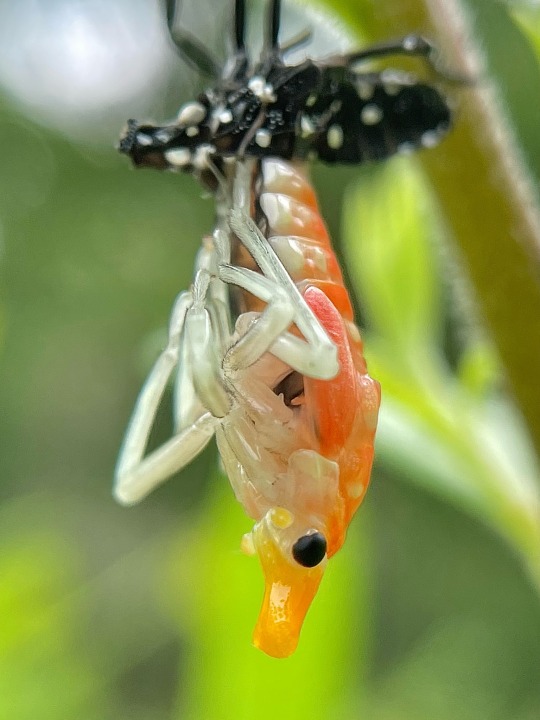
a good post on the topic of killing invasive species by @bowelfly :
795 notes
·
View notes
Text


If you live in the northeast United States, then you’ve probably seen or at least heard of these guys. The Spotted Lanternfly. Or Lycorma delicatula.
They’ve been rapidly expanding and growing in population and while their presence is too new to know the exact impact they have on our native flora, they seem to pose a major threat to the apple and grape industries. They also excrete a honeydew that leads to mold growth on the plants they feed on.
So the states have put out this message to the public: “If you see it, smush it.”
And while I understand the need to be ruthless in invasive species response, I hope that people aren’t associating all lanternflies with this “bad bug” label.
So right now I’d like to showcase some cool/interesting species of lanternflies (the family name is Fulgoridae) in their native habitats :)

Peanut-Headed Lanternfly (Fulgora laternaria)

No Common Name (Phrictus diadema)
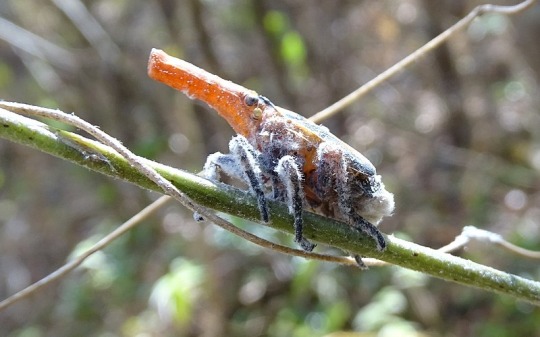
Malagasy Lantern Bug (Zanna madagascariensis)

No Common Name (Pyrops delessertii)
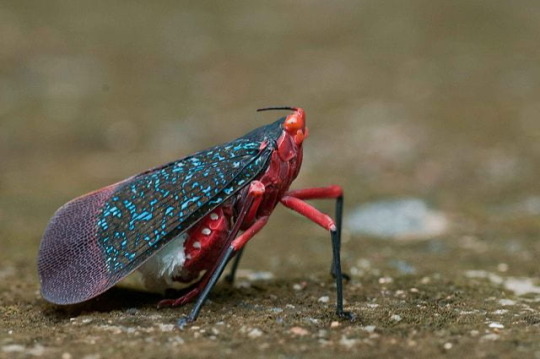
No Common Name (Kalidaysa lanata)
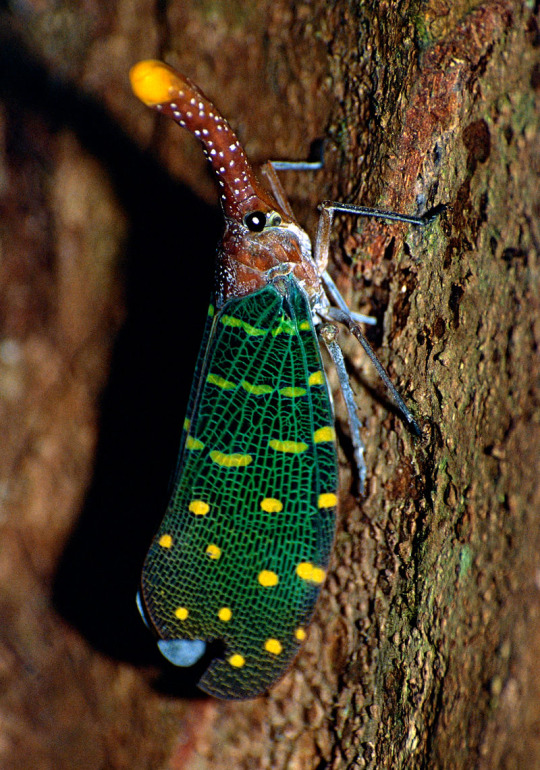
No Common Name (Pyrops intricatus)
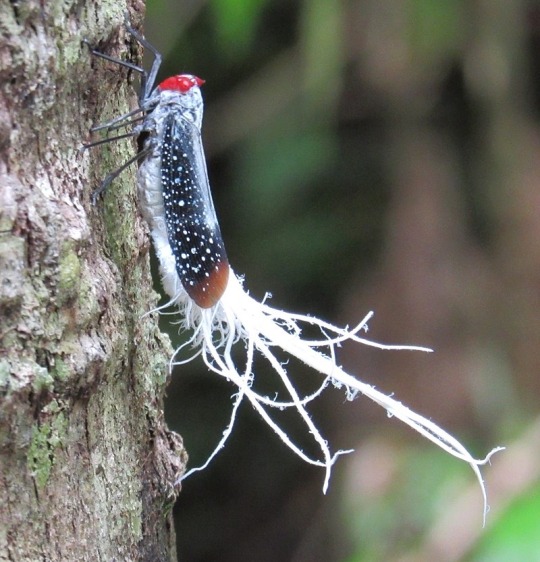
Wax-Tailed Planthopper (Lystra lanata)
Fulgoridae has over 500 species making it a fairly large hemipteran family, please go on a Wikipedia dive to look at all of them. Happy bugging :))
#insects#entomology#bugs#lanternflies#spotted lanternfly#bugblr#planthopper#ecology#invasive species#hemiptera#pretty pretty bugs#i love them all
158 notes
·
View notes
Text
Insect Pinning Tutorial
This is going to be a very surface-level lesson in insect pinning for display. Let's say you have captured an insect you wish to pin. One such as this Spotted Lanternfly (Lycorma delicatula).

The first step is to create a killing jar. This tool dispatches your quarry using toxic fumes, giving you an intact corpse you can display. What you need is an airtight container, nail polish remover, and a tissue. Now, scientifically, the ideal chemical to use is ethyl acetate. But in the absence of that, nail polish remover works. The setup is simple: you make the tissue lightly damp using your dispatching chemical, place it inside the container, add the insect, and close it up. Now, because I am slightly rusty and the opening on this bottle is large, I used more than necessary and the tissue was soaked.

Ideally, you do not want to wait too long to perform the next step as you want your corpse to be fresh and pliable...but also not wait too short, as you want it to be dead and not unconscious. This is when you get out your pinning board and insect pins. The board is optional as long as you have a sheet of styrofoam, but the pins are a little less DIY. You will need to have insect pins ahead of time in order to pin an insect.


What you want to do here is position your corpse dorsal-side up (belly down) and push a pin through its pronotum, the "shield" behind its head. Traditionally, a hemipteran such as this should be pinned instead through its scutellum, the segment of the thorax after the pronotum which lies between the wings, but as previously stated I am rusty and also it's too late. If I were to re-do it, the hole would bother me. Incidentally, with beetles, the target for pinning is the right elytron (plural elytra), the hardened forewing characteristic of beetles which forms a hard cover over the flying wings.

The next step is to use more pins to pose the insect's limbs. Now, because I had to go to work, I did in fact wait a little long to pin my lanternfly. And as a result, its legs were not as pliable as I would have preferred. But as I said above, this is already imperfect. And perfection is overrated anyway.

Now, something a professional might do is spread its wings which would show off this species' bright red abdomen. However, this is an optional step which requires more precision and patience. And as mentioned, my subject was already becoming rigid. Come morning, it will have finished drying out and remain in this pose without the pins holding its legs.
And that is how you pin an insect. I am by no means a professional and it has been about a decade since I last performed this technique, but hopefully you have learned something.
37 notes
·
View notes
Text
October 29th, 2023


Spotted Lanternfly (Lycorma delicatula)
Distribution: Native to parts of China and Vietnam; introduced to Japan, South Korea and North America; found mostly in the northeast, but spreading westward and southward.
Habitat: Usually found on its host plants; its preferred host is tree of heaven, but it can also be found on many other plants such as fruit trees, ornamental trees, woody trees and vines.
Diet: Herbivorous; feed on the sap found in the phloem of plants. Besides their preferred host, other common targets include birch, lilac, maple and poplar, as well as important agricultural crops like soybeans, grapes, stonefruit, cherry trees and apple trees.
Description: The spotted lanternfly is very invasive, and is considered a threat to many important agricultural crops. When it feeds, it pierces the bark of its host plant, forming a wound which may cause pathogens to be introduced into the plant. On top of that, spotted lanternflies also produce honeydew, a sugary substance which attracts other pests such as hornets, wasps and ants, and on which can grow mold. It seems to have a preference for plants which contain cytotoxic byproducts, which makes it toxic when eaten.
In its native range, the local lanternfly population is controlled by parasitic wasps. Unfortunately, it doesn't have any important predators outside of its native range due to its toxic properties. On the bright side, the honeydew can serve as a food source for honeybees, which reportedly produces a pleasant change in the flavor of their honey and brings some resistance to parasitic mite infestations.
(Images by Darrah Lefler (adult) and Stephen Ausmus (nymph))
20 notes
·
View notes
Photo

Lycorma delicatula - Spotted Lanternfly nymphs
#insects #entomology #bugblr #nycbugs #spotted lanternfly #invasive #planthopper #auchenorrhyncha
14 notes
·
View notes
Text


Spotted Lanternfly, Lycorma delicatula
9 notes
·
View notes
Text

Lycorma delicatula シタベニハゴロモ
2021, Japan


3 notes
·
View notes
Text
PSA and TW Insects
Spotted lantern flies were spotted in IL! They're an invasive species so please photograph them and kill them and their larvae!
Screen shot of the news story and an image of their life cycle is below
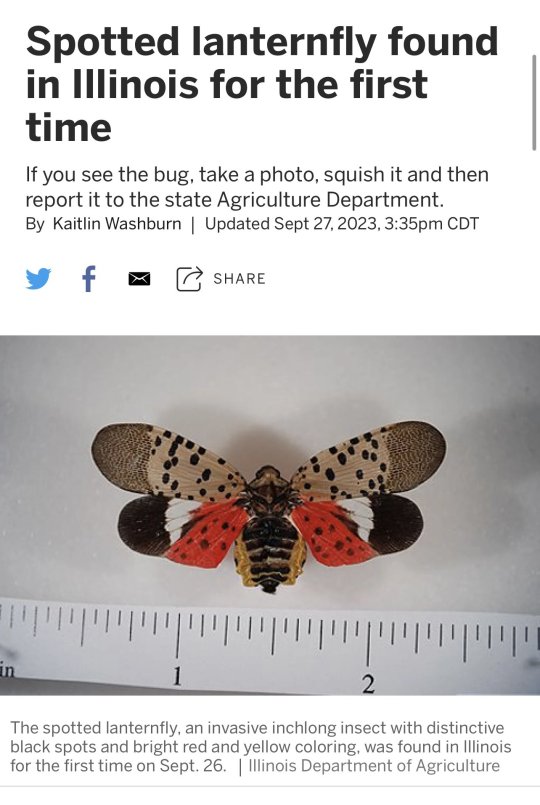
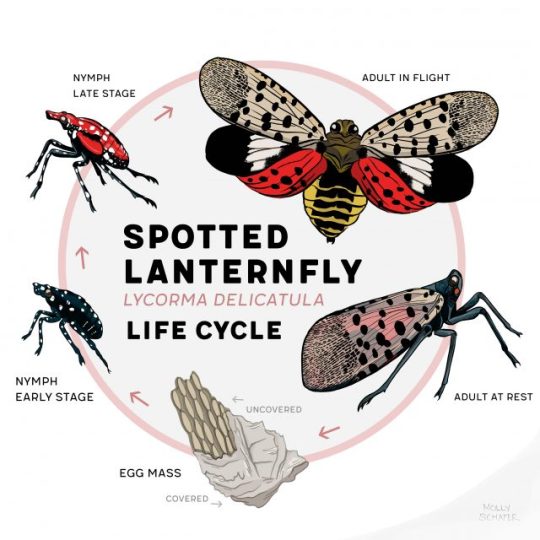
0 notes
Note
Here in NYC, Spotted lanternflies are an invasive species that are harmful to native plants and animals. I've heard conflicting accounts on whether killing them helps or does nothing and is just cruel. What are your thoughts on (for lack of a better word) vigilante justice for lanternflies?
there’s only really two reasons that people kill lanternflies: 1) they have been misinformed by every source that tells them to do so & think they’re doing something useful 2) they’re sadistic creeps who enjoy killing things and because of 1) it’s socially acceptable. maybe 3) if they’re destroying your plants or if you are allergic to mildew or something
people killing lanternflies one by one or even small local populations chemically isn’t going to eradicate them. it would be nice if they never got here or if they suddenly disappeared, but unfortunately they are here to stay and can only be controlled by introducing highly specific targeted control organisms like parasitic wasps, or the local ecosystem adapting to their presence. made a post about this recently that explains more
135 notes
·
View notes
Text
In North Carolina, Guilford and Forsyth counties are officially labeled as having infestations. Spotted lanternflies have been found in 14 other counties, including Onslow and Currituck in the east.
0 notes
Text
What You Need To Know About the Spotted Lanternfly
What is the spotted lanternfly? If you live in Pennsylvania, you have probably already seen this insect. The spotted lanternfly (lycorma delicatula or SLF) is an invasive species native to China and Southeast Asia.
The pest was discovered in Pennsylvania in 2014, specifically Berks County, and has spread throughout Pennsylvania and neighboring states: north to Massachusetts, south to North Carolina, and west to Indiana and Michigan (See the Spotted Lanternfly distribution map for the mid-Atlantic area). The spotted lanternfly feeds on and damages many different plant species.
Many homeowners have reported sightings and damage from this pest, both direct damage by feeding and secondary damage due to excessive sooty mold formation on lanternfly excrement (honeydew). As part of our series on invasive insects, here is what you need to know and what you can do if you spot the colorful insect around your property.
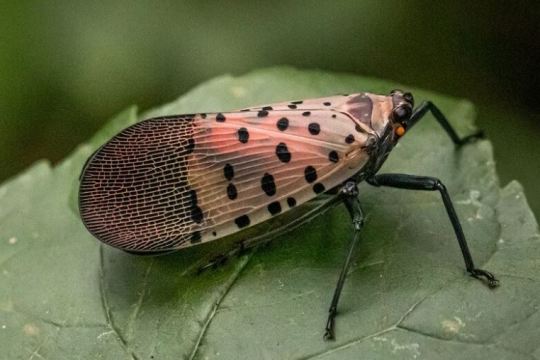
What You Need to Know About the Spotted Lanternfly
As of 2023, the spotted lanternfly is reported to be found in 51 Pennsylvania counties and can build to astounding numbers when left unmanaged. While many Pennsylvania residents have spotted this invasive species on their landscapes, we have some information to help those who want to keep their landscape free from invasive insects.
Appearance
Adult spotted lanternflies can be identified by their coloration and bodies. The insect has grayish wings with black spots; the tips are black and gray, while the bodies are black. When flying, spotted lanternflies will show vibrant red hind wings. Adults are around 1 inch long and a half-inch wide with wings folded. They can jump several feet when startled or approached.
You can also identify the pest via their egg masses or nymph stage. Egg masses are typically found on tree bark on the underside of scaffold branches and occasionally on other smooth surfaces such as rocks, outdoor furniture, and even vehicles. The mass is usually around 1 inch long and a half to three-quarters of an inch wide, with a gray-brown, mud-like covering.
Spotted lanternfly nymphs are much smaller than adults, only about 1/8 to 1/2 an inch long (depending on instar: a phase between two periods of molting in the development of an insect larva or other invertebrate). However, nymphs have distinct coloration: initially black with white spots and wingless, developing red patches/red patches and white spots as they mature.
Behavior & Problems
Spotted lanternflies feed on plant sap, and at a high population, this can cause significant damage to an area’s plant life. While known to feed on over 70 different plants, spotted lanternflies have strongly preferred the tree of heaven (ailanthus altissima), grapevines, maple trees, black walnut, birch, willow, and styrax.
Feeding on tree and plant sap can cause wilting, leaf curling, and dieback. In addition, as the SLF feeds on plant sap, the insect excretes a sugary substance called “honeydew,” which can attract bees, wasps, and other insects, and promotes the growth of sooty mold, which causes further damage to plants.
Here are the months each life stage occurs to help you better identify the plant pest on your property.
Egg masses: The invasive pest usually lays eggs from September to November, and lanternflies spend the winter as eggs.
Nymphs: Nymphs will first hatch around May to June and mature until around July to September.
Adults: July to September is when most spotted lanternflies have matured into adults; mating and egg-laying can continue until December.
The insect has become so prevalent that Pennsylvania has put affected counties under quarantine to stop the movement and slow the insect’s spread to new areas within or out of the current quarantine zone. The quarantine involves traveling and transporting outdoor items.
What You Can Do
If you see any spotted lanternfly or signs of its damage on your property, contact Burkholder Plant Health Care (PHC). Burkholder PHC treats for spotted lanternflies as part of our plant health care program. Our plant health care program emphasizes proper diagnosis and precise treatment, using only state-of-the-art, research-backed methods and equipment. We also utilize various pest management and control processes to protect your landscape from invasive, harmful pests.
Additional Spotted Lanternfly Resources
For more information about spotted lanternfly issues in Pennsylvania, you may wish to visit the following resource links.
Cooperative State Program Homepage
Cooperative State Program Map
Pennsylvania Quarantine Details/Updates
Pennsylvania Quarantine Map
Mid-Atlantic SLF Distribution Map
Contact Burkholder Brothers for Plant Health Care Services
If you want to keep your landscape beautiful, healthy, and free of spotted lanternfly, contact Burkholder PHC for a consultation. Our team of plant health care professionals has decades of experience helping homeowners keep their landscapes as healthy and vibrant as possible. In addition, we have up-to-date knowledge of the latest plant health care methods, from pest control to soil care and more. For more information on our services, contact us today.
Blog is originally published at: https://www.burkholderphc.com/what-you-need-to-know-about-the-spotted-lanternfly/
It is republished with the permission from the author.
0 notes